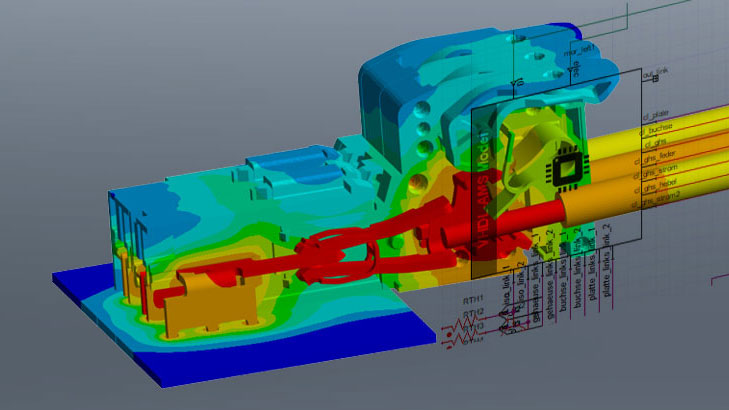AI, HPC & Quantum Computing: The Future of Simulation-Driven Product Innovation
Joël Grognuz
16.07.2024
Interview Part 1 with Dr Prith Banerjee, CTO at Ansys
At the CADEFM Conference 2024 we talked to Prith Banerjee, CTO at Ansys. In the interview he shares his most recent projects with us and shows us what engineers and users can expect in the future.
Prith, you are CTO at Ansys. On which technologies are you working at the moment?
We have about 50 different products across 10 business units. What I am driving as CTO at Ansys are five technology pillars. First: Advanced Numerics – in the core of Ansys, we take physics equations, and we solve them with numerical methods. In the core of the numerical methods, we are looking at Advanced Geometry Meshing techniques, multiphysics interactions, multiscale methods, high order methods, mesh fusion technologies, etc.
The second area is high-performance computing. Our solvers often take thousands of hours to run, so we make the solvers run much faster. There are various technologies using shared memory multiprocessors, message passing using MPI, GPU-based technologies. In the future, we are working on things like quantum computing and AI-based hardware.
This is the third area, AI/ML. We are using AI/ML to drive much faster solvers as well as easier-to-use technologies. So we talked about technology around SimAI to run things much faster, Ansys GPT to make our customers' lives easier in terms of the use of our tools.
The fourth pillar is about cloud and platforms. Many of our customers are taking our solvers and running them on the cloud like AWS or Azure. We have a SaaS-based cloud platform that we're working on, and then we are taking all our solvers, providing Python interfaces to the solvers, and allowing our customers to build entire apps or workflows to run our solvers in the backend.
The final fifth pillar is around digital engineering, which is the whole concept of model-based systems engineering. We can take a system-level requirement in languages like CSML and then use it to drive collaboration across multiple teams.
The question that most of our users have is how to get started with all that. What would you recommend them to start with or how?
Obviously, that depends on the customer. For example, if they're already using simulation and they have a challenge with respect to runtime – then they will use our HPC capabilities, running it on shared memory or message passing or GPUs. If they want to get even higher speed ups, super linear speed, then they may try using our AI tools. If they have access to the cloud, they can use our cloud software and so on. But the most important technology with respect to digital transformation is actually our digital engineering area. That is the thing that I really stress a lot these days.
In the past, different customers used to have different functions: a mechanical engineering group that was only looking into the mechanical parts. And the fluids group was working on the fluids part, the electromagnetics group was working on electromagnetics. And the teams collaborated by sending emails or Excel sheets. In the new world of digital engineering, you come up with the system architecture model, which is this single-authored source of truth, and that is going to drive all the designs. So, my guidance to customers is, to home in on this digital engineering pillar and see how they can do much faster designs, reduce the design iterations, and do it at much lower cost.
Dr. Prith Banerjee, CTO Ansys, Inc. | © CADFEM Germany Gmbh
You briefly mentioned Quantum Computing. What are you doing on this?
When I joined Ansys, my CEO asked me, what is the technological disruptor. I told him it is AI and machine learning. We worked on it for the last five years and we have created new technologies, ANSYS GPT and ANSYS AI Plus. That technology is now out there.
So then my CEO asked, 'What's the next technology?'. That is Quantum Computing. It's not going to happen in the next three years, but in the next 10 to 15 years. I am absolutely sure that Quantum Computing is going to be a technology that everybody will use. And I will tell you why: If you have a problem that takes 10,000 hours to run and you give it 100 processors, we can take that thousands of hours and make it run in 10 hours. You get linear speedup: You have p processors; you get p times speedup.
With Quantum Computing, if I have p qubits, the speedup will be 2 to the power of p, which is like exponential. If today’s IBM system Q has 433 qubits, or they have 1,000 qubits, they're announcing things with 2,000 qubits, 4,000 qubits by the year 2024: So the speedup will be 2 to the power of 433, 2 to the power of 4,000, which is a massive thing.
Something that takes you 10,000 hours to run today will work in seconds. No time for coffee anymore. The thing is it’s not yet clear how Quantum Computing can solve numerical methods simulation. But at one point, I also didn't know how AI and ML would solve the problems; we changed that. I am similarly making a bet that Quantum Computing will change the way simulation will be accelerated in the future. I'm very excited about that.
Watch now the full interview with Prith Banerjee on our YouTube channel!





